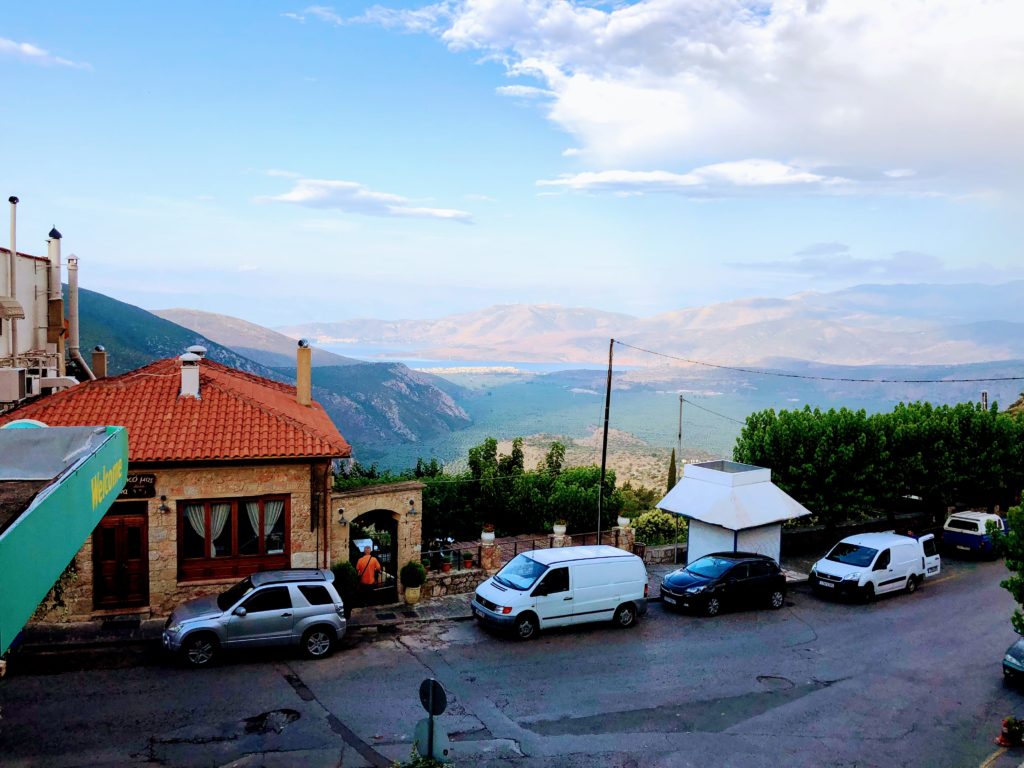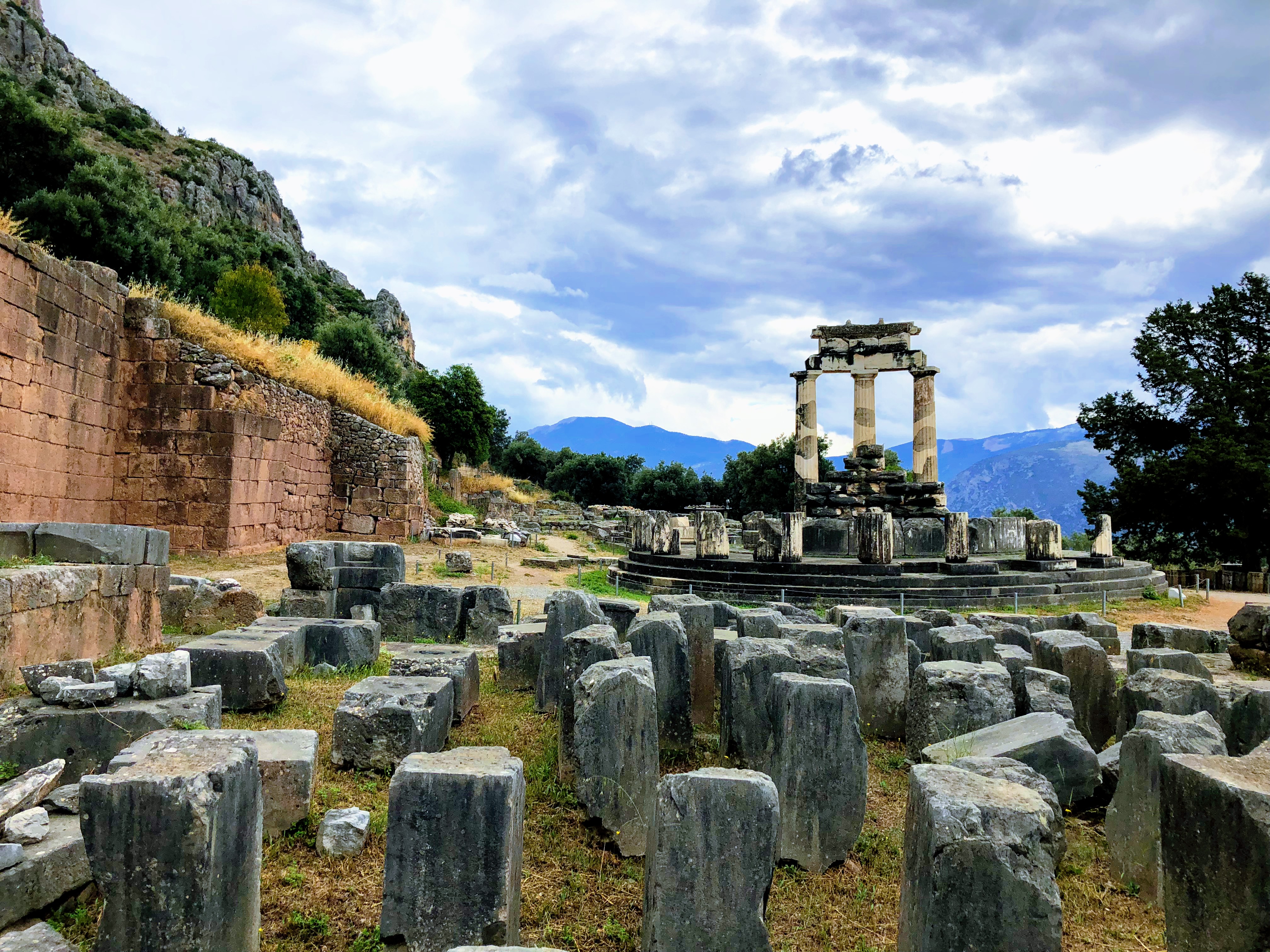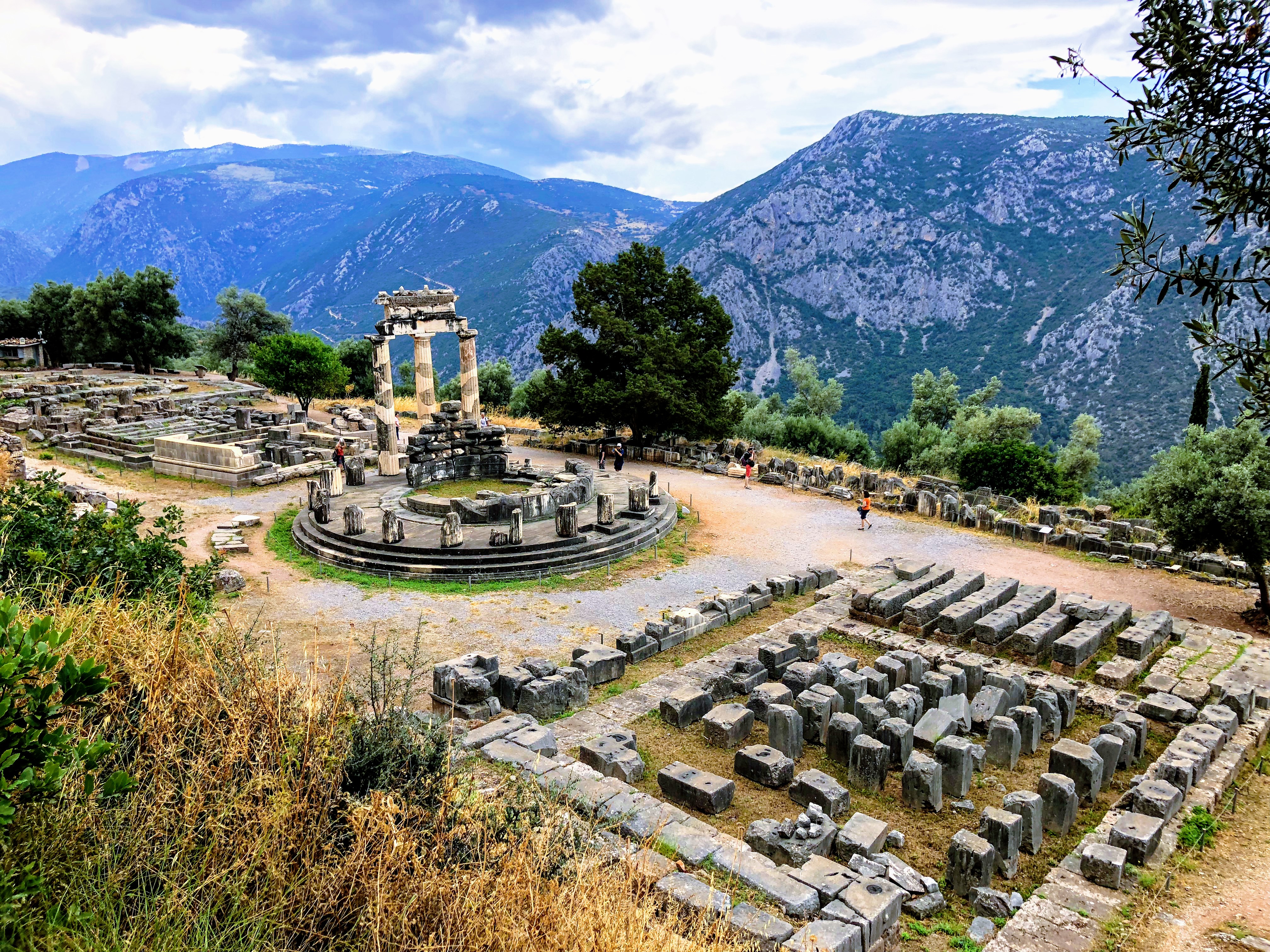Day: 198-199 Location: Delphi, Greece
 June 18-19, 2018
June 18-19, 2018
My little mishap with the car rental cost us more than the 11euro non-refundable rental fee : it cost us time (and comfort)! Unable to drive ourselves, we were at the mercy of the Greek bus and train schedules. And it was terrible. We waited what seemed like hours for our bus in Kalambaka. After about 5 hours and two buses later, it stopped in a random city and the driver unceremoniously made us disembark, unplanned , and instructed us that another bus would be taking us to our final destination of Delphi. 2 hours later and we finally arrived at our hotel, exhausted. Our mood perked up a bit when shortly after entering our room, there was a gently knock on the door and a lively woman was carrying a tray with 2 wonderful glasses of wine. Now that was more like it.
 View from our room of the coastal plain and the valley of Phocis
View from our room of the coastal plain and the valley of Phocis
Delphi is an important part of Ancient Greek history. Formerly called Pytho, it was an ancient sanctuary that featured prominently in many historic events. I couldn’t wait to explore this famous site in the morning!
Delphi was also considered the centre of the world, for in Greek mythology, Zeus released two eagles, one to the east and another to the west, and Delphi was the point at which they met after encircling the world.
 Lucky for us, the weather was on our side and provided for breathtakingly clear views
Lucky for us, the weather was on our side and provided for breathtakingly clear views
Delphi was an important ancient Greek religious sanctuary sacred to the god Apollo. Located on Mt. Parnassus, it was originally sacred to Gaea, mother goddess of the earth, who placed her son Python, a serpent, as a guard for Delphi and its oracle. Apollo, god of light and music, slew the serpent and took over the site for himself.

Priestesses who served Apollo there were called the “Pythia,” named in honour of Gaea’s vanquished son. Throughout the classical world spread the belief that these priestesses channeled prophecies from Apollo himself.

The oracle of Apollo at Delphi was famed throughout the Greek world and even beyond. The oracle – the Pythia or priestess – would answer questions put to her by visitors wishing to be guided in their future actions by way of vague and often cryptic prophecies.

The priestess sat above a chasm in the earth, which belched forth fumes. She breathed deeply – some believe that the fumes possessed hallucinogenic properties – and slipped into semi-consciousness. Her prophecies were opaque, often frantic. This was the Oracle of Delphi: the Greeks’ most famous and most feared window into the will of the gods.

750m east of the village, the Sacred Way, the path that climbs to its centrepiece Temple of Apollo, was lined in ancient times by treasuries and statues, erected by city-states including Athens and Sparta to thank Apollo and assert their own wealth and might. Some stand complete, most lie in ruins, but together they form a magnificent spectacle. It’s remarkable to walk amongst the ruins; it evokes the feeling that transcends time and places you right in the thick of mythological history.
The entire Delphi Archaeological site is considered a UNESCO World Heritage Site and it’s easy to see why. Not only is its historical importance impressive but the site itself – and the views- are magnificent!

Climbing further up the mountain, lies the the remarkably intact remains of a theatre , host to play and performances during the ancient Phythian Festival, staged every four years. It is this view that stopped me in my track and kept me captivated for over an hour. I let my friend continue upwards and sat on the edge of the stone wall, and simply took in the view. To this day, this remains my very favourite view.
 No words can adequately describe the feeling of standing over this amazing sight.
No words can adequately describe the feeling of standing over this amazing sight.
Sanctuary of Athena Pronea

For ancient pilgrims, whether they be seeking the wisdom of the Oracle or coming to worship Apollo, the first stop once they arrived in Delphi was the Sanctuary of Athena Pronaia (meaning “who is before Apollo”). Set just below the road, 800m east of the Sanctuary of Apollo, this picturesque spot was built in honour of the goddess Athena.
While the Sanctuary contained a grouping of temples and treasuries, the most famous (and photographed) one is the Tholos of Delphi, a lovely circular structure of unknown purpose that dates from the 4th century BC.
 Of the original twenty, three Doric columns of the Tholos of Delphi remain. The were reconstructed over time: the white portions are original marble, the darker are new.
Of the original twenty, three Doric columns of the Tholos of Delphi remain. The were reconstructed over time: the white portions are original marble, the darker are new.
Delphi definitely delivers a punch. It encompassed everything I love when travelling: history, amazing sights and astonishing landscapes. Having grown up with a keen interest in Greek mythology (I almost became a history teacher because of it!), I loved my experience in the ‘centre of the ancient world’, fully immersed in the world of gods and goddesses, cults and cultures and mythological mysteries.
Exhausted but content, we settled in for the night, ready to tackle yet again, another long voyage in the morning. During the last four days, we had taken 29 different modes of transportation( trains, buses, metros and taxis)! Now, it was time for the 30th: an airplane taking us across the Aegean Sea to the Cyclades island of Santorini.
